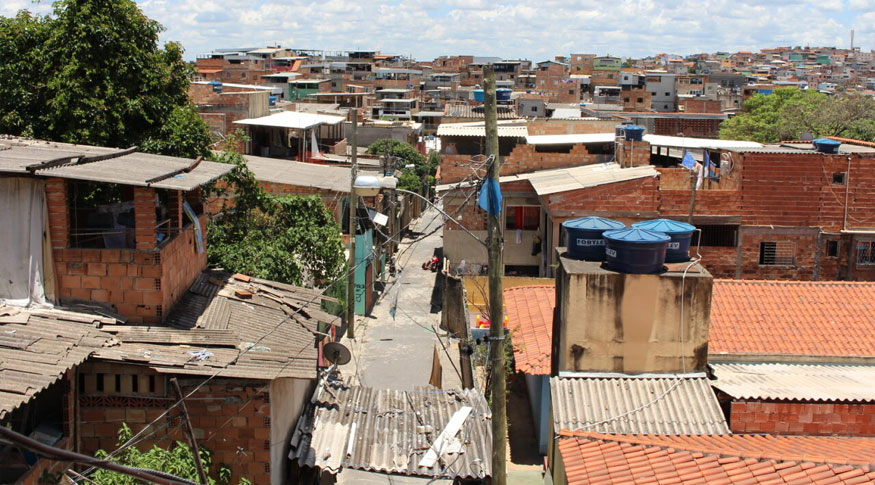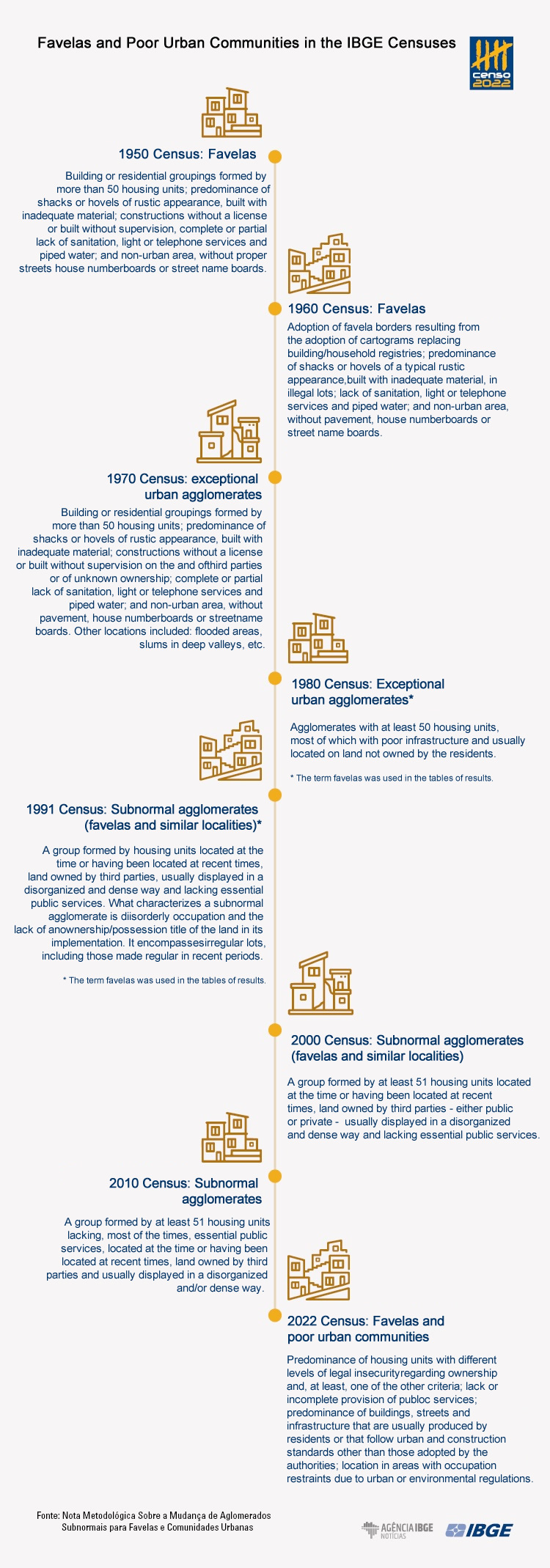
For the original press release in Portuguese, published by Brazil’s census bureau, the Brazilian Institute of Geography and Statistics (IBGE), click here.
The Brazilian Institute of Geography and Statistics (IBGE) is substituting the term “Subnormal Agglomerations,” adopted for its censuses and research since 1991. The new designation, extensively discussed by the institute with social movements, the academic community, and various government bodies, will now be “Favelas and Urban Communities.” With this change, IBGE returns to the term “Favela,” historically used by the institute since 1950, along with the term “Urban Communities,” representative of more recent identifications. There has been no change to the criteria that shape the identification and mapping of these areas and that guided the collection of the 2022 Demographic Census. The change involves the adoption of a new name and the rewriting of the criteria, reflecting the institute’s new approach.
“The results of the 2022 Census will be released in the second semester, in line with the criteria used for identification, mapping, and census collection. The new name was chosen based on technical studies and consultations with various segments of society, ensuring that the dissemination of the 2022 Census results aligns with the population’s fundamental constitutional rights,” says Cayo de Oliveira Franco, Geography Coordinator of the IBGE Geosciences Directorate.
According to UN-Habitat 2022 projections, approximately one billion people currently live in favelas and informal settlements worldwide. This number might be underestimated, given the challenges in data collection across various countries and the dynamic nature of the formation and dispersion of these territories. UN-Habitat reports that, in 2021, about 56% of the global population lived in urban areas, and this rate is expected to climb to 68% by 2050.
Since the beginning of the 21st century, in the field of international statistics on favelas and urban communities, a collaborative effort, primarily led by UN-Habitat, has focused on establishing globally recognized nomenclatures and parameters for the identification and mapping of these areas. The indicators developed to monitor the Sustainable Development Goals, for example, require constant refinement in the production of information about these areas.
Besides being an important actor in defining these agendas, IBGE is the body responsible for data production covering all favelas and urban communities in the country. This includes addressing the challenge posed by their historical and geographical diversity.
IBGE found several key issues in the use of the expression “Subnormal Agglomerations.” The legal grounds for the change in nomenclature is the right to housing, considered a fundamental human right since the 1948 Universal Declaration of Human Rights, and enshrined in Article 6 of the 1988 Federal Constitution. Consequently, there is a provision allowing people to mobilize available means to make this right viable, including self-construction and the occupation of urban spaces to fulfill their social function. The right to adequate housing is also described in Comment nº. 4 of the United Nations Committee on Economic, Social and Cultural Rights report, published in 1991.
Similarly, articles 182 and 183 of the 1988 Federal Constitution address the social function of property and the instrument of adverse possession. It’s also noteworthy to mention the City Statute (Law No. 10 257/2001) and the set of laws dealing with urban land regularization.
IBGE had already been conducting a series of consultations to review the nomenclature since 2003. In 2021, the Favelas and Urban Communities working group was formed to support the enhancement of the 2022 Census at all stages of the research and to resume the task of reformulating the “Subnormal Agglomeration” label. Finally, in September of last year, the First National Meeting for the Production, Analysis, and Dissemination of Information about Favelas and Urban Communities in Brazil was held.
The Head of the Social Territories Sector, Jaison Luis Cervi, highlights some decisions established through the consultations. Among them was the unanimous acceptance of the term favela, linked to the historical demand for this recognition by popular movements. There was consensus on the need for the term to be accompanied by another complementary term. Furthermore, it was determined that the concept should have a positive meaning and contain an element of affirmation rather than stigma, reinforcing the identity and unique forms of organization within these territories.
“It was also established that the concept should refer to the territories as having unmet rights, rather than as territories that do not comply with legislation. Although it is central to highlight the power of these communities, it was also mentioned that the lack of rights and assistance is evidenced in public statistics,” says Cervi.
Based on these inputs, IBGE proposed a new set of writing criteria and selected possible alternatives for a revised nomenclature. The two options garnering the most acceptance in these consultation and participatory instances were: “favelas and urban communities” and “favelas and working-class areas.”
Based on this systemization, additional internal and external meetings were held. The name “Favelas and Urban Communities” was found to be most consistent with the discussions held during the process, as it is also commonly used by community leaders involved in this debate. The popularity of the term was highlighted, particularly its use outside of the Southeast Region, as well as its strong relevance to the social and community practices of these areas.
“Thus, the modes of creating, making, and living, recognized in Article 216 of the Federal Constitution, are now valued through a name people can relate to,” added Cervi.

The 1950 census survey raised several challenges regarding the identification, mapping, and classification of favelas, beginning with the construction of the concept of favela, which, originally coined in Rio de Janeiro, was little known in other Brazilian regions at that time. The results of this survey highlighted the relevance of specific studies on these areas, as they found that 7.2% of the population of Rio de Janeiro, then the Federal District, already lived in favelas that year.
The 1960 Census maintained the name “favelas” to describe these areas. Contrasting with the 1950 Census, the count of favelas in Rio de Janeiro surged from 58 to 147. Notably, this Census marked the first time IBGE used its own maps for urban research, replacing traditional household-property registrations. The escalating urbanization process added both dimension and complexity to this evolving topic.
The 1970 Census adopted the terminology “Exceptional Urban Agglomerations.” Despite the change in terminology, the new concept essentially mirrored the one used for favelas in the 1950 Census. This term aimed to address the necessity for conducting distinct sample surveys and specific tabulations.
The 1980 Demographic Census maintained the identification of special sectors and omitted the term “exceptional” from the concept, now referred to as the “Special Sector of Urban Agglomerations.” For the first time, statistical tabulations were conducted in these areas, expanding the scope of results that, in 1950 and 1960, were confined to the then Federal District. Data on the resident population were compiled by sex, occupied private households, and the average number of people per occupied private household, categorized by municipalities and favelas. In that year, 2,280,063 people were recorded living in 487,729 permanent private households within favelas.
The 1990 Census, postponed to 1991, was the first survey to adopt the concept of “Subnormal Agglomeration,” accompanied by the parenthetical addition “Favelas and Similar Areas.” This census marked the shift where the criteria of land irregularity became the primary identification method for agglomerations, always linked to at least one indicator of substandard urban patterns or inadequate access to essential public services. A total of 4,482,637 people were counted residing in 1,028,911 households within these areas.
In this census, Municipal Census Commissions were established with the role of aiding in population mobilization in each municipality and providing support during the data collection stage. Additionally, the Advisory Committee was formed, consisting of experts who offered opinions on the content of the questionnaires, the data sample, calculation methods, and other aspects.
The 2000 Census marked the strengthening of the discussion with civil society regarding the production of public statistics, retaining the term “Subnormal Agglomerations” to encompass areas known as favelas, communities, villages, housing developments, glens, stilt communities, among others. A total of 6,535,634 people were counted living in 1,662,868 permanent private homes in Subnormal Agglomerations (favelas and similar areas).
It is important to emphasize that the 2000 Demographic Census coincided with the MUNIC surveys of 1999 and 2001. The MUNIC surveys reported 1,269 municipalities with the presence of “favelas and the like,” a number significantly higher than indicated by the 2000 Census Territorial Base, which accounted for subnormal agglomerations in 225 municipalities. Divergences between MUNIC and the 2000 Census also extended to the numbers of favelas recorded in municipal registries and the counts of households in these areas according to the compilation of municipal information. These differences later prompted various institutional efforts to enhance the procedures for identifying and mapping these areas.
The 2010 Census marked significant progress in the identification of subnormal agglomerations, maintaining, however, the primary nomenclature used in the 1991 and 2000 Censuses and omitting the expression “favelas and the like” that accompanied the name. A total of 11,431,619 people were counted living in 3,229,434 permanent private homes in Subnormal Agglomerations.
In the 1991 and 2000 Censuses, these territories were considered for very restricted data tabulations and for distinguishing sector aggregates. However, in the 2010 Demographic Census, IBGE produced specific publications aiming to underscore their significance as a crucial differentiator of the socioeconomic conditions of the population. There was a particular emphasis on their distribution across the national territory and the optimal utilization of variables from both the basic and sample questionnaires. Detailed results for each cluster were also made available, contributing significantly to urban studies in Brazil and the development of local public policies.
The results presented between 1980 and 2010 reflect the methodological and operational improvements in the research, enabling a more precise identification of these territories nationwide. However, the numbers do not allow for conclusions regarding the dynamics of the emergence, expansion, or removal/resettlement of favelas, making result comparisons challenging. In preparation for the publication of the 2022 Demographic Census results, IBGE is currently analyzing their comparability with those of 2010. This includes identifying territories that already existed but were not identified in that year, as well as areas that underwent expansion or forced evictions.
